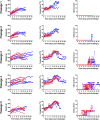Genomic changes of Lassa virus associated with mammalian host adaptation
- PMID: 40375146
- PMCID: PMC12079963
- DOI: 10.1186/s12864-025-11666-y
Genomic changes of Lassa virus associated with mammalian host adaptation
Abstract
Background: Lassa virus (LASV) causes a severe haemorrhagic fever in humans, with estimates of 100,000 to 300,000 infections annually in endemic regions and accounting for around 5000 deaths. The natural reservoir is the Mastomys rat, but through zoonotic transmissions humans are accidental hosts. Regular outbreaks continue to exert pressures on public health systems, with its ability to cause nosocomial infections posing risks to healthcare workers. It is a concern that larger outbreaks and introduction of LASV to new territories will intensify, including risk of adaptation to new mammalian host reservoirs.
Results: To evaluate genetic changes in LASV during adaptation to a new host, a guinea pig model of infection was utilised. Initial infection with LASV stocks cultured from cell culture resulted in only mild or subclinical disease. To study the susceptibility in naïve animals, the virus was serially passaged which increased clinical signs during disease progression ultimately resulting in severe disease. An RNAseq and consensus mapping approach was undertaken to evaluate nucleotide changes in LASV genome from each animal at each passage.
Conclusions: During adaptation to guinea pigs, no significant new mutations occurred. Instead, a selection pressure on two genes of the L segment was observed resulting in their increased frequency in the genome population during passaging.
Keywords: Adaptation; Changes; Lassa virus; Mutation; Passage.
© 2025. Crown.
Conflict of interest statement
Declarations. Ethics approval and consent to participate: All procedures with animals were performed in accordance with the United Kingdom Animals (Scientific Procedures) Act 1986 under UK Home Office project license (ref P82D9CB4B). An ethical review was performed by the UK Health Security Agency Animal Welfare and Ethical Review Board (AWERB). Consent for publication: Not applicable. Competing interests: The authors declare no competing interests.
Figures





Similar articles
-
Inoculation route-dependent Lassa virus dissemination and shedding dynamics in the natural reservoir - Mastomys natalensis.Emerg Microbes Infect. 2021 Dec;10(1):2313-2325. doi: 10.1080/22221751.2021.2008773. Emerg Microbes Infect. 2021. PMID: 34792436 Free PMC article.
-
A Lassa Fever Live-Attenuated Vaccine Based on Codon Deoptimization of the Viral Glycoprotein Gene.mBio. 2020 Feb 25;11(1):e00039-20. doi: 10.1128/mBio.00039-20. mBio. 2020. PMID: 32098811 Free PMC article.
-
Lethal Infection of Lassa Virus Isolated from a Human Clinical Sample in Outbred Guinea Pigs without Adaptation.mSphere. 2019 Sep 25;4(5):e00428-19. doi: 10.1128/mSphere.00428-19. mSphere. 2019. PMID: 31554720 Free PMC article.
-
Systematics, Ecology, and Host Switching: Attributes Affecting Emergence of the Lassa Virus in Rodents across Western Africa.Viruses. 2020 Mar 14;12(3):312. doi: 10.3390/v12030312. Viruses. 2020. PMID: 32183319 Free PMC article. Review.
-
Lassa virus diversity and feasibility for universal prophylactic vaccine.F1000Res. 2019 Jan 31;8:F1000 Faculty Rev-134. doi: 10.12688/f1000research.16989.1. eCollection 2019. F1000Res. 2019. PMID: 30774934 Free PMC article. Review.
References
-
- Ogbu O, Ajuluchukwu E, Uneke CJ. Lassa fever in West African sub-region: an overview. J Vector Borne Dis. 2007;44:1–11. - PubMed
-
- Moore KA, Ostrowsky JT, Mehr AJ, Johnson RA, Ulrich AK, Moua NM, Fay PC, Hart PJ, Golding JP, Benassi V, et al. Lassa fever research priorities: towards effective medical countermeasures by the end of the decade. Lancet Infect Dis. 2024;24:e696–706. - PubMed
MeSH terms
Grants and funding
LinkOut - more resources
Full Text Sources

